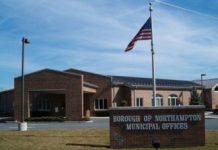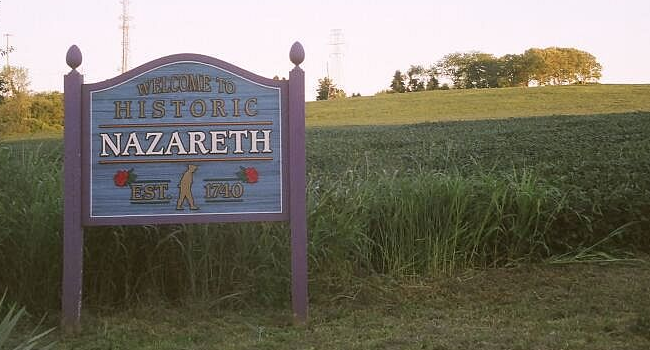The Moore Township Planning Commission met Monday, April 25 at Moore Elementary. Among the items discussed were a simple minor subdivision sketch plan and a presentation for the updated Nazareth Area Regional Comprehensive Plan.
Surveyor Michael Hahn laid out a sketch plan and addressed the commission on behalf of Christopher and Laura DeVatt regarding a simple minor subdivision for their land.
The DeVatt’s sketch plans showed their proposal to split their land into two parcels. The land currently sits on East Scenic Drive and Deemer Road. Although they are in the beginning phases of the subdivision, they requested the commission’s opinions so they could assess the costs and see what their best options were while they are figuring out what they want to do with the land.
The DeVatt’s land also has wetlands near the back of their property, and they asked if a wetland study would be needed for their subdivision. The wetlands, however, will stay on the original dwelling with approximately 12.5 acres, and the remaining 10.5 acres is farming land they have no plans to build on at this time.
Township Engineer Kevin Horvath identified the wetlands will not be an issue and a wetland study will most likely not be needed.
Chairman John Becker pointed out his concern about septic failure in the future and making sure they have enough land on the original dwelling for a second solution if a septic problem ever arises.
Becker advised DeVatt they will most likely have to pay recreation fees for one lot and application fees for this subdivision since a wetlands study is not needed.
The other item on the agenda was the Lehigh Valley Planning Commission’s presentation for the Nazareth Area Regional Comprehensive Plan by Director of Environmental Planning, Geoff Reese.
Reese expressed the NazPlan is a multi-municipal comprehensive plan encompassing 10 communities in the area. The point of the presentation was to give an overview of the updated plan and allow the commission to address any formal comments within the next two weeks before they move forward with the next steps of their plan.
According to Reese, the purpose of the Nazareth Area Multi-Municipal Comprehensive Plan is to enable the boroughs of Bath, Chapman, Nazareth, Stockertown and Tatamy, and the townships of Bushkill, Hanover, Lower Nazareth, Moore and Upper Nazareth to shape their collective vision for the future. The plan will build on the eight-community Nazareth Area Comprehensive Plan adopted in 2007 to define shared objectives and collaborate on implementation regarding important issues that face the Nazareth area.
Additionally, NazPlan will set public policy for transportation, utilities, land use, recreation, agriculture, education, housing, and other local priorities. The plan will ultimately guide decisions, research, reports, and funding as the official legal strategy influencing the growth, development, and preservation of the Nazareth area assets.
Reese identified that the Nazareth area plan’s core principles are to create higher density in existing developed areas, incorporate mixed land uses in existing and new development areas, enhance walking, rolling, biking, and transit use for daily trips, which includes commuting to work, to preserve natural resources, preserve farmland and cultural, historic, and scenic resources, enhance recreational opportunities for all persons, reduce transportation-related emissions and congestion, appropriately locate future land uses, create high-quality jobs and a skilled workforce, create diversity in housing choice for all income levels, create and enhance partnerships, and to enhance funding opportunities for needed improvements in the area.
During the presentation, Reese discussed NazPlan’s seven important goals with accompanying policies.
Goal 1 outlines reducing development stress on existing utility infrastructure with policies that will match development intensity with sustainable utility infrastructure capacity, strengthen the utility infrastructure in the region, and provide high-quality community facilities and services for all residents.
Goal 2 outlines balancing preservation and development with policies on protecting natural resource areas, preserving farmland and farming, promoting compact development and higher densities in designated growth areas, educating and collaborating across public, private, and governmental entities on the effects of land use decision-making on resiliency and quality of life, preservation of historic, cultural, and scenic resources and landscapes, permitting mineral extraction in areas where it is compatible with surrounding land uses, and providing ample park and recreational opportunities for Nazareth area residents.
Goal 3 addresses improving air and water quality with policies on protecting, conserving, and enhancing woodland resources, especially near rivers, streams, and wetlands, reducing transportation-related emissions, reducing greenhouse gas emissions from residences, government operations, and businesses, and protecting the quality and quantity of surface water and groundwater.
Goal 4 regards increasing the attainability of housing with policies on improving and maintaining the conditions of existing housing units for suitable living environments, ensuring new housing developments meet the needs of all current and future Nazareth area residents, and prioritizing housing initiatives in areas with access to jobs, social opportunities, and multimodal transportation.
Goal 5 discusses mitigating the impacts of increasing traffic on roads and infrastructure with policies on minimizing impacts of freight movement on transportation infrastructure, implementing comprehensive traffic-calming techniques for local roads, right-size transportation infrastructure projects, and encouraging and providing for active transportation.
Goal 6 details identifying the appropriate site locations for warehouse and industrial development with policies on coordinating warehouse and industrial land development with available road capacity, transit service, and utility infrastructure, promoting context-sensitive design for industrial and warehousing facilities, and protecting environmental and community assets.
Goal 7 addresses directing investments and resources to maximize the Nazareth area’s economic strengths and diversities with policies on enhancing the character and economic viability of natural, mineral, cultural, and historic assets, including traditional downtowns, crossroads villages, and historic farmsteads, supporting economic development strategies to target industry sectors that match the unique competitive advantages of the region, connecting growing job and population centers, building a pipeline of highly skilled workers that is aligned with the current and future needs of regional employers by creating stronger linkages between employers, education, and workforce training, and reducing the impacts of natural and non-natural hazards.
At this point in the plan, Reese explained there are no other responsibilities from the boroughs and townships other than formally submitting questions, comments, and concerns. Since Moore Township was the last of the ten communities to be presented with the updated plan, the commission has two weeks to submit comments before the next steps of the plan implementation, which include the plan adoption. Although the overall timeframe for the project is not speculated to come to complete fruition until 2045, Reese explained that some parts of the plan will require more time to work through than others, which is what the timeframe accounts for.
More information about NazPlan can be found on their website, NazPlan.org.
The next Moore Township Planning Commission meeting will be Monday, May 23 at 7 p.m.









